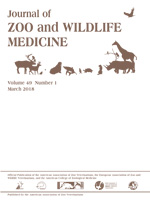An 8 yr, intact male red-rumped agouti (Dasyprocta leporina) was evaluated for weight loss. Examination revealed poor body condition, hypercalcemia, elevated serum 25-hydroxyvitamin D, metastatic calcification of soft tissues, and hyperechoic kidneys. The diet, formulated for laboratory rodents, contained elevated levels of vitamin D3. Histopathology from a female conspecific that died 5 mo prior identified dystrophic mineralization and nephrosclerosis, suggestive of a vitamin D3 toxicity. The male agouti responded well to a dietary reduction in vitamin D3 and calcium. Six months into therapy, progressive renal failure was identified and was further managed with enalapril, phosphorus binders, and dietary manipulation. Suspected vitamin D3 toxicity has been reported in pacas (Cuniculus paca) and agouti and has been linked to exposure to New World primate diets. In this brief communication, an agouti developed suspected hypervitaminosis D after receiving a commercial rodent diet commonly fed to this species in captivity.
How to translate text using browser tools
1 March 2018
SUSPECTED HYPERVITAMINOSIS D IN RED-RUMPED AGOUTI (DASYPROCTA LEPORINA) RECEIVING A COMMERCIAL RODENT DIET
Kadie M. Anderson,
Albert Lewandowski,
Patricia M. Dennis
ACCESS THE FULL ARTICLE
Agouti
Dasyprocta leporina
hypercalcemia
hypervitaminosis D
vitamin D





